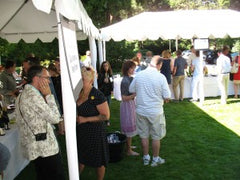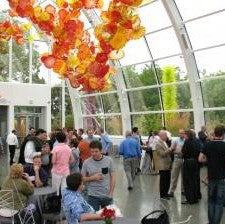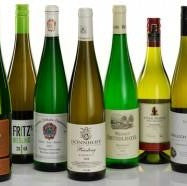A mix of 150 wine trade members and consumers gathered July 16-18 in Seattle for the fourth Riesling Rendezvous.
Opening remarks by event sponsor Chateau Ste. Michelle’s president Ted Baseler started with him thanking Australia’s Frankland Estate for being the furthest traveling to his city to attend RR. Asserting that “the noble white wine is back!” he also admitted to a slight downturn in Riesling sales asking if it was Moscato, cocktails, or other reasons to blame. “The category has slowed down with Riesling imports down 13%. Personally I’d really like to blame it on Moscato,” but having looked at the demographics said that’s “not why it’s happening. Consumers today are interested in contemporary package designs, so we need innovative packaging to attract Riesling consumers. Consumers know that Riesling is very food-friendly especially with the Mediterranean diet; chefs should be on the Riesling bandwagon. Restaurant should implement ‘wine by the glass’ programs which emphasize Riesling’s special tastes.”
Co-sponsor Ernie Loosen addressed the issue of how to attract new Riesling drinkers from other wines. “When we are visiting a market consumers usually love Riesling but there must be a way to have consumers to try it on their own. The overall image of Riesling has recovered well amongst trade and the media but how do we captivate the consumers?” Different methods of marketing or making wines sprung to his mind but he warned against making wines without character in order to just pull in new customers. Why the success of Pinot Grigio and Moscato?
Later, Loosen’s old pal Stuart Pigott pointed out the great leap in quality for Riesling made in many regions, the interest in Riesling in younger consumers over older ones, that “the older Chardonnay addicts are lost people…and they need therapy.”
 Author John Haeger led a panel tasting of 20 dry Rieslings served blind to the panel as well as the audience. Author/journalist Stephen Brook spoke of being raised, as were most Brits of his generation, with sweeter and fruitier Mosel wines until being “forced by Bernhard Breuer to taste 30 dry Rieslings.” Many 2011 and 2012 were tasted with the oldest example Clare Valley’s Jim Barry Florita 2005.
Author John Haeger led a panel tasting of 20 dry Rieslings served blind to the panel as well as the audience. Author/journalist Stephen Brook spoke of being raised, as were most Brits of his generation, with sweeter and fruitier Mosel wines until being “forced by Bernhard Breuer to taste 30 dry Rieslings.” Many 2011 and 2012 were tasted with the oldest example Clare Valley’s Jim Barry Florita 2005.
Conspicuous in its absence was any representation of Alsace. According to Stephanie Teuwen, who represents the CIVA for the US, “The EU did not renew their support and we had a serious budget cut this year, so we had to cut events from our 2013 program.” Try as he might, event organizer Kirk Wille of Loosen Bros. Imports was unable to attract any participants from France to join.
For his ‘Proving That Terroir Matters’ presentation Dr. Ulrich Fischer of the Rheinland-Pfalz government research station showed sensory and chemical results along with nine wines showing that terroir has a sustainable impact on the sensory expression of wine, and that “this unique combination of natural aspects of the vineyard will be a unique selling proposition in the global competition” forming the base for a regional realization of added value. The dimension with a wine is created by the interactions between the grapevine, the bedrock and soil type, topography, and mesoclimate–and indirectly the winemaker taking part via vita-vinicultural practices. Working with vintages
2004-2008 he and his panel tasted the Deidesheimer Kieselberg and Forster Pechstein vineyards made by Bassermann-Jordan. He noted organoleptic variables coming from the influences imparted by soil differences in the 2004 vintage with a less pronounced effect in subsequent, cooler vintages.
….to be continued. Read our next post for Part II…
Check back here to post or read follow-up comments and to check out our next blog post.
Learn more about the origins, other homes and characteristics of Riesling in our Rieslings of the World Workshop.
Check out our full schedule of programs, workshops and public events. Private, customized experiences and corporate training is also available.


